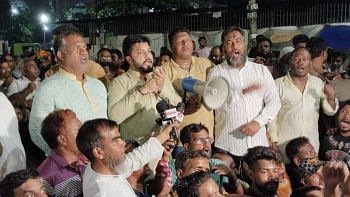Girls Deserve a Better Normal

The Covid-19 pandemic has been hard for everyone, but it has been especially so on children. Millions of children across the world have been cooped up at home for weeks (or months) on end, away from their classrooms and their friends, many of them mourning the loss of someone they loved. It is probably difficult for adults to understand just how unsettling this "new normal" has been for young minds, but a recent report from Unicef, titled "The State of the World's Children," painted a grim picture of how the impacts of Covid-19 on the mental health of children and young people are likely to be felt for many years to come. The latest data suggests that at least one in seven children in the world has been directly affected by lockdowns, and some 1.6 billion children have suffered some loss of education.
This loss of education has been felt keenly in Bangladesh, which saw one of the most prolonged school closures in the world. During the 543 days that educational institutions remained shuttered here, the children did not only suffer from learning loss, but also from the twin threats of child labour and child marriage—to a degree far greater than usual.
Even before the pandemic, the world witnessed its first increase in child labour in the past two decades (8.4 million more during 2016-2020), and a Unicef report in June this year warned that another nine million children were globally at risk of being pushed into child labour by the end of 2022 as a result of the pandemic. In Bangladesh, research from Manusher Jonno Foundation and its partner organisations found that, between August and October in 2020, 5,600 child labourers migrated in search of jobs and 2,400 were forced to join new work at minimum wage.
That Covid-19 forced many children from low-income families to join the workforce is now widely acknowledged. What is even more frightening is that the government project to eradicate hazardous child labour from Bangladesh, which was taken up more than three years ago, saw only 1.33 percent progress by its original deadline in December last year, according to a June report from the planning ministry's Implementation Monitoring and Evaluation Division (IMED). The repercussions of such a blasé attitude towards child labour became clear after the Hashem factory fire in Narayanganj, on July 8 this year, where at least 17 child labourers were killed—11 of whom were girls. Most of these children were found to have taken up factory jobs because of school closures and their families' financial struggles during Covid-19.
Too many Bangladeshi girls, while managing to avoid the trap of child labour, have instead fallen into the chokehold of child marriage during the pandemic. It is astonishing that the relevant authorities did not try to collect any data regarding how schoolgirls, especially from low-income backgrounds, were faring during the period of school closures—despite Unicef warning that an additional 10 million girls worldwide are at the risk of child marriage due to Covid-19, and despite the fact that almost half of the estimated 650 million girls and women in the world who were married in childhood hail from Bangladesh, Brazil, Ethiopia, India, and Nigeria.
Media reports from across the country confirm that a good number of girls are failing to return to school. Last week, Brahmanbaria teacher Pankaj Kanti Madhu went viral on social media after he was photographed calming his student's three-month-old baby at Chinair Anjuman Ara High School. He was applauded for taking the initiative to bring his student—a tenth-grader who was forced to become a child bride—back to school. But why should this be limited to the personal initiatives of sincere teachers? What is being done on a national level to ensure that the girl students, who were married off during the Covid-19 shutdown of schools, are able to return to education?
Today, as we observe the end of National Child Rights Week and celebrate the International Day of the Girl Child, we must ask ourselves some serious questions about the present state of children in Bangladesh, and what is being done on a national level to support them. And in these considerations, the topics of education loss, child labour, and child marriage must feature heavily. Child marriage, in particular, requires urgent attention. Bangladesh has the highest rate of child marriage in South Asia—and this was the case even before the pandemic. An astonishing 51 percent of young women in Bangladesh are married before their 18th birthday. Of these child brides, 50 percent give birth before the age of 18, and 80 percent before the age of 20. Nearly one in three child brides has a spouse who is at least 10 years older than her.
However, research in Bangladesh also suggests that child marriage begins to decline among those with at least 10 years of schooling, and prevalence falls below 50 percent among those with at least 12 years of schooling. In fact, Unicef strongly suggests that education levels make more of a difference in the prevalence of child marriage than wealth or place of residence. In this context, the education authorities should have organised re-enrolment campaigns targeting the most high-risk groups of children, long before they decided to reopen schools.
Beyond attempts to include girls in education, a lot more is left to be done. There has to be a radical shift in how we perceive child marriage as a nation. Families and communities must understand that it is not a tool to protect the "honour" of young girls, but rather a form of sexual violence. However, this kind of message—when it comes from a government that has willingly lowered the age bar of child marriage to 16 under "special circumstances" (with no clear guidelines on what those circumstances are)—sounds rather insincere. The fact that the Child Marriage Restraint Act, 2017 does not actually criminalise the marital rape of a minor, and does not include the option for marriage annulment, only further reflects a general apathy towards improving the lives of girl children in Bangladesh.
Looking at some of last month's reports alone paints a powerful picture of the dualities facing girls in this country. In September, five Bangladeshi girls defeated teams from around the world with their idea for a green urbanisation project, winning USD 2,580 from a global charity. Soon after, another schoolgirl in Kushtia, named Nargis Nahar, was found to be the only one of the eight female students from her class to return to school; the rest of them had been forced into child marriages during the pandemic.
In September, Nubaysha Islam, an eighth-grader from Sylhet, competed against over 100,000 youths and won the first prize in the International Letter Writing Competition 2021. September also marked one year since the death of 14-year-old migrant worker Kulsum, who was sent to Saudi Arabia as a domestic worker with false documents in April 2018, and returned to her family in Bangladesh in a body bag on September 12, 2020, covered with marks of torture.
At the beginning of the month, nine people were held on the charge of abetting and raping a schoolgirl in Narayanganj. At the end of the month, a man was arrested on charge of raping and killing a schoolgirl in Satkhira, while another was sued for raping a mentally challenged girl in Habiganj.
Also in September, 10-year-old Nilava Chowdhury made her league debut in the National Women's Chess League, and ended up beating Rani Hamid, the country's first woman international master and 20-time national chess champion.
It is clear that our girls have all the potential to reach for the stars, but also have to live in fear of having their wings clipped. How many more will grow into adults without ever enjoying their rights as children? How long until we are able to allay the fears of our children, and provide them with the decent, secure, and enabling environment that they deserve?
Shuprova Tasneem is a member of the editorial team at The Daily Star. Her Twitter handle is @shuprovatasneem

 For all latest news, follow The Daily Star's Google News channel.
For all latest news, follow The Daily Star's Google News channel. 



Comments